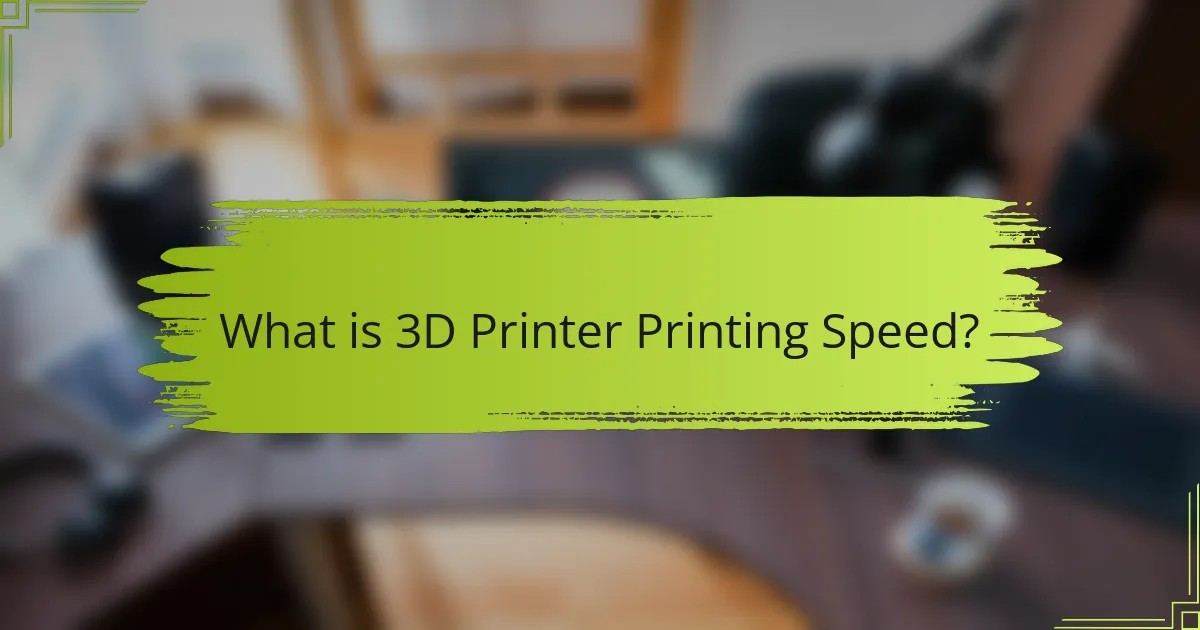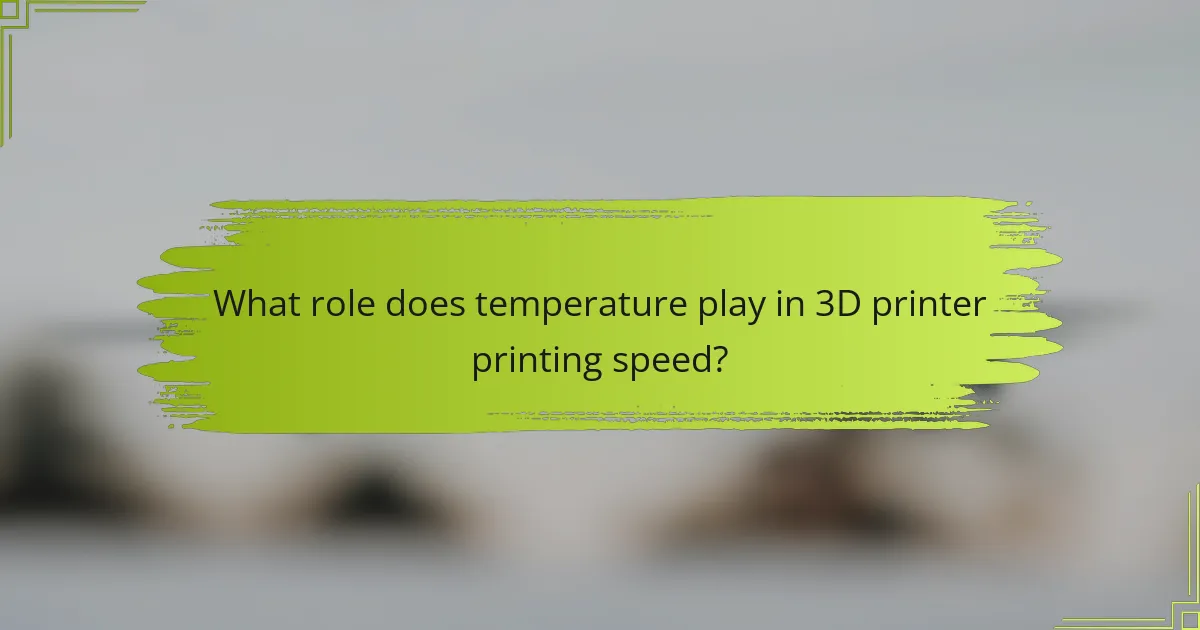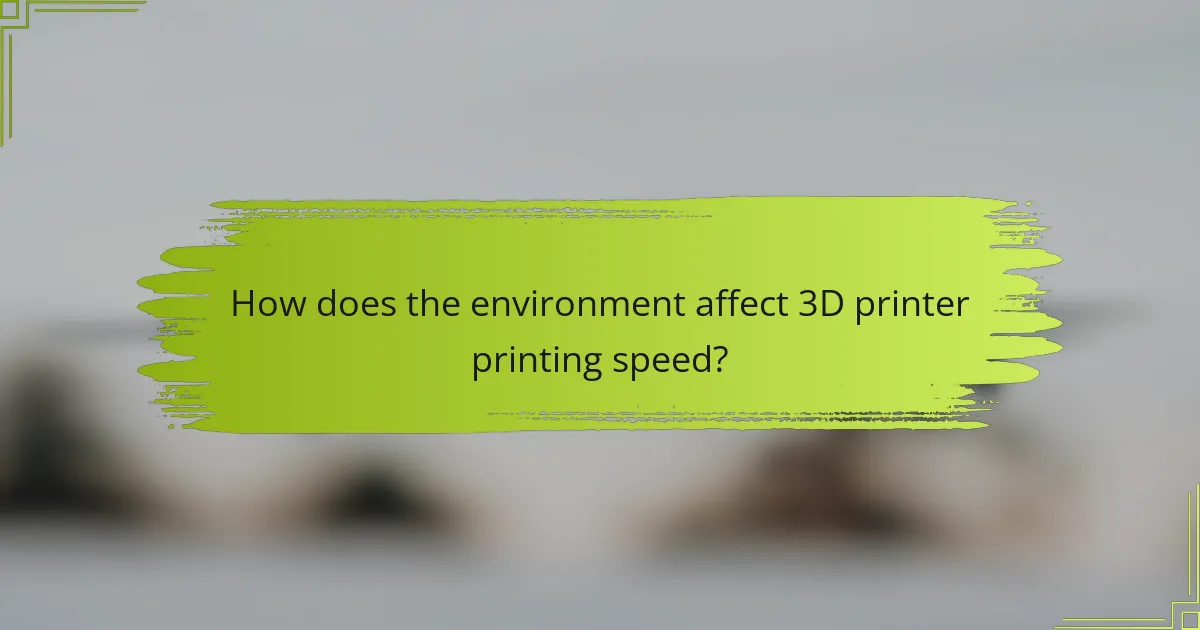
What is 3D Printer Printing Speed?
3D printer printing speed refers to the rate at which a 3D printer can produce layers of material to create an object. This speed is typically measured in millimeters per second (mm/s). Common printing speeds range from 20 mm/s to 300 mm/s, depending on the printer and material used. Factors influencing speed include layer height, nozzle size, and printer technology. For instance, FDM printers often have slower speeds compared to SLA printers. Higher speeds can lead to reduced print quality, while lower speeds generally improve detail. In summary, printing speed is a critical factor that affects both efficiency and quality in 3D printing.
How is printing speed measured in 3D printing?
Printing speed in 3D printing is measured in millimeters per second (mm/s). This metric indicates how fast the printer’s nozzle moves while extruding material. For example, a typical printing speed can range from 30 mm/s to 100 mm/s. Higher speeds can reduce print quality and detail. Conversely, lower speeds often improve layer adhesion and surface finish. Manufacturers usually specify optimal speed settings for different materials. Testing different speeds can help achieve the desired balance between speed and quality.
What units are used to quantify printing speed?
Printing speed is typically quantified in millimeters per second (mm/s). This unit measures how fast the print head moves while printing. For 3D printers, this speed can significantly impact print quality and time. Higher speeds can lead to faster prints but may affect the detail. Conversely, lower speeds often result in higher accuracy. Manufacturers usually specify the optimal printing speed for their machines in mm/s. This standardization helps users compare different printers effectively.
How does layer height influence printing speed?
Layer height significantly influences printing speed in 3D printing. A smaller layer height results in more layers being printed for the same object, which increases the overall print time. Conversely, a larger layer height reduces the number of layers, leading to faster print completion. For instance, using a layer height of 0.1 mm can take up to 50% longer than using a height of 0.3 mm for the same model. This is because the printer spends more time moving up and down between layers when the height is smaller. Therefore, adjusting layer height is a critical factor in optimizing printing speed.
Why is printing speed important in 3D printing?
Printing speed is important in 3D printing because it directly affects production efficiency and print quality. Faster printing speeds can reduce the time required to create prototypes or final products. However, excessive speed may lead to defects such as layer misalignment or poor adhesion. Research shows that optimal printing speeds balance speed and quality, ensuring structural integrity. For instance, studies indicate that printing at speeds above 60 mm/s can compromise detail in intricate designs. Therefore, understanding the relationship between speed, temperature, and environment is crucial for achieving desired outcomes in 3D printing.
What impact does printing speed have on print quality?
Printing speed significantly impacts print quality in 3D printing. Higher speeds often lead to reduced detail and accuracy in the printed object. The material may not have sufficient time to adhere properly, resulting in weak layers. This can cause issues like warping or layer separation. Conversely, slower speeds generally enhance print quality. They allow for better material flow and layer bonding. Studies show that an optimal speed range improves dimensional accuracy. For example, a speed of 50 mm/s may yield better results than 100 mm/s in certain materials. Thus, balancing speed and quality is crucial for successful 3D printing.
How does printing speed affect production time and efficiency?
Printing speed directly influences production time and efficiency in 3D printing. Higher printing speeds reduce the time required to complete a print job. For instance, a 3D printer with a speed of 100 mm/s can finish a model in half the time compared to one operating at 50 mm/s. Increased speed can lead to higher throughput, allowing more parts to be produced in a given timeframe. However, excessively high speeds may compromise print quality and accuracy. Research indicates that optimal printing speeds balance time efficiency and print fidelity. A study by Huang et al. (2020) in the Journal of Additive Manufacturing found that maintaining a speed of around 60 mm/s maximizes both efficiency and print quality. Thus, while faster printing can enhance efficiency, it must be managed to ensure quality is not sacrificed.

What role does temperature play in 3D printer printing speed?
Temperature significantly influences 3D printer printing speed. Higher temperatures can reduce the viscosity of the filament. This allows for smoother extrusion and faster layer adhesion. Consequently, the printer can operate at higher speeds without compromising print quality. Conversely, lower temperatures may increase filament viscosity. This can lead to clogging and slower printing speeds. Studies show that optimal temperature settings can enhance layer bonding and overall print efficiency. For example, PLA filaments typically print best between 190°C and 220°C. Adjusting temperature can thus optimize printing performance and speed.
How does nozzle temperature affect printing speed?
Nozzle temperature significantly affects printing speed in 3D printing. Higher nozzle temperatures typically allow for faster extrusion of filament. This is because the filament becomes more fluid at elevated temperatures, reducing its viscosity. As a result, the printer can move more quickly without clogging or under-extruding. Conversely, lower nozzle temperatures can lead to slower printing speeds. At these temperatures, the filament may not flow as easily, causing jams or inconsistent extrusion. Research indicates that optimal nozzle temperature enhances layer adhesion and overall print quality, further supporting the benefits of adjusting temperature for speed.
What are the optimal temperature ranges for different materials?
The optimal temperature ranges for different 3D printing materials vary significantly. For PLA, the ideal printing temperature is between 180°C to 220°C. ABS performs best at temperatures ranging from 220°C to 250°C. PETG typically requires a range of 220°C to 250°C for optimal results. Nylon, on the other hand, has a recommended temperature range of 240°C to 260°C. TPU, a flexible material, works well at 210°C to 230°C. These temperature ranges ensure proper layer adhesion and minimize warping. Consistent adherence to these ranges leads to improved print quality and mechanical properties.
How does temperature influence filament flow and adhesion?
Temperature significantly influences filament flow and adhesion in 3D printing. Higher temperatures generally reduce filament viscosity, allowing for smoother flow through the nozzle. This improved flow can enhance layer adhesion, as the molten filament fuses better with previously laid layers. Conversely, lower temperatures can increase viscosity, leading to poor flow and weak adhesion. Insufficient adhesion can result in warping or layer separation during the print process. Research indicates that optimal extrusion temperatures vary by filament type, with PLA typically printing best between 180°C and 220°C. Maintaining the correct temperature is crucial for achieving high-quality prints with strong adhesion.
What is the relationship between bed temperature and printing speed?
Bed temperature affects printing speed in 3D printing. Higher bed temperatures can reduce warping and improve adhesion. This allows for faster print speeds without compromising quality. Conversely, lower bed temperatures may lead to layer separation and increased print failure rates. Research indicates optimal bed temperatures enhance flow characteristics of the filament. For example, PLA typically performs best at bed temperatures around 60°C. This reduces the likelihood of print defects, enabling consistent and faster printing. Thus, maintaining appropriate bed temperature is crucial for achieving optimal printing speed and quality.
How does bed temperature impact the first layer adhesion?
Bed temperature significantly impacts first layer adhesion in 3D printing. Higher bed temperatures help prevent warping and promote better adhesion of the filament to the print bed. This is particularly important for materials like ABS and PLA, which are sensitive to temperature changes. A heated bed can maintain a consistent temperature, reducing the likelihood of the filament cooling too quickly. Studies show that optimal bed temperatures can enhance adhesion by up to 50%. This improved adhesion leads to better print quality and reduces the chances of failed prints.
What effects does bed temperature have on warping and shrinking?
Bed temperature significantly affects warping and shrinking in 3D printing. A heated bed helps maintain consistent material temperature during the printing process. This consistency reduces thermal gradients that cause warping. Materials like ABS are prone to warping if the bed is too cool. Conversely, a properly heated bed can enhance adhesion, minimizing shrinkage. Studies indicate that optimal bed temperatures improve print quality and dimensional accuracy. For example, maintaining a bed temperature of around 100°C for ABS can effectively reduce warping incidents. Thus, controlling bed temperature is crucial for successful 3D printing.

How does the environment affect 3D printer printing speed?
The environment significantly affects 3D printer printing speed. Factors such as temperature, humidity, and airflow impact the printing process. Higher temperatures can enhance filament flow, thus increasing speed. Conversely, extreme heat may lead to warping or layer adhesion issues. Humidity can cause filament absorption, resulting in inconsistent extrusion. This inconsistency slows down printing as adjustments are necessary. Airflow affects cooling rates, which can influence layer solidification times. Proper environmental control can optimize printing speed and quality.
What environmental factors can influence printing speed?
Environmental factors that can influence printing speed include temperature, humidity, and airflow. Temperature affects the viscosity of the printing material. Higher temperatures can reduce viscosity, allowing for faster extrusion. Conversely, low temperatures can increase viscosity, slowing down the process. Humidity can impact the material’s absorption characteristics. High humidity can lead to moisture absorption in filaments, causing inconsistent flow and slower speeds. Airflow around the printer can also affect cooling rates. Adequate airflow can help maintain optimal temperatures for printing, enhancing speed. Inadequate airflow can lead to overheating, which may slow down the printing process.
How do humidity levels affect filament performance?
Humidity levels significantly affect filament performance in 3D printing. High humidity can lead to filament absorption of moisture. This moisture causes issues like bubbling, stringing, and poor layer adhesion during printing. Filaments such as PLA and Nylon are particularly susceptible to moisture. For instance, Nylon can absorb up to 10% of its weight in water. This absorption results in reduced strength and increased brittleness in printed parts. Conversely, low humidity levels help maintain filament integrity and improve print quality. Proper storage of filament in low-humidity environments is crucial for optimal performance.
What is the impact of ambient temperature on printing speed?
Ambient temperature significantly impacts printing speed in 3D printing. Higher temperatures can lead to faster printing speeds due to improved material flow. When the ambient temperature is too low, materials may become brittle, slowing down the extrusion process. Conversely, optimal temperatures enhance adhesion and reduce warping, which can also contribute to increased speed. Studies indicate that maintaining an ambient temperature around 25°C can optimize performance. For instance, a research study by K. T. K. Phan et al. demonstrated that printing speed improved by up to 30% within this temperature range.
How can environmental control enhance printing speed?
Environmental control can enhance printing speed by optimizing temperature and humidity levels. Maintaining a stable temperature prevents warping and ensures consistent material flow. Controlled humidity reduces the risk of moisture absorption in filament, which can lead to printing defects. Proper ventilation can also help dissipate heat from the printer, allowing for faster layer cooling. Research shows that optimal environmental conditions can increase print speed by up to 30% while maintaining quality. Studies indicate that printers operating within ideal temperature ranges achieve higher throughput rates. These factors collectively contribute to more efficient and faster 3D printing processes.
What methods can be used to regulate temperature and humidity?
Methods to regulate temperature and humidity include using thermostats, humidistats, and HVAC systems. Thermostats maintain a set temperature by controlling heating and cooling systems. Humidistats monitor and control humidity levels to ensure optimal conditions. HVAC systems integrate heating, ventilation, and air conditioning to manage both temperature and humidity effectively. Additionally, dehumidifiers and humidifiers can be employed to adjust moisture levels. Proper insulation also plays a vital role in maintaining stable temperature and humidity levels. These methods are essential in environments like 3D printing, where precise conditions can significantly affect printing speed and quality.
How does an enclosed printer affect printing speed and quality?
An enclosed printer enhances printing speed and quality by maintaining a stable temperature. This stability reduces warping and improves layer adhesion during the printing process. Enclosures protect the print from drafts and temperature fluctuations. As a result, the filament extrudes more consistently. A study by the University of Southern California found that enclosed environments can increase print accuracy by up to 30%. Additionally, enclosed printers often allow for better control of humidity levels. This control further contributes to improved print quality and reduces the chances of failed prints.
What are best practices for optimizing 3D printer printing speed?
To optimize 3D printer printing speed, adjust print settings such as layer height and print speed. Using a larger layer height reduces the number of layers, leading to faster prints. Increasing the print speed setting allows the printer to move more quickly.
Calibrating the printer correctly is essential for maintaining speed without compromising quality. Ensure the nozzle and bed temperatures are set appropriately for the filament type. Higher temperatures can improve flow rates, enabling faster extrusion.
Utilizing a direct drive extruder can enhance speed as it reduces the distance filament travels. Additionally, ensure the printer is well-maintained and free of obstructions to facilitate smooth operation.
Finally, consider using a simplified model design to minimize complexity, which can also speed up the printing process.
How can users adjust settings for improved printing speed?
Users can adjust settings for improved printing speed by modifying layer height, print speed, and infill density. Increasing layer height reduces the number of layers printed, leading to faster results. Adjusting print speed allows users to find a balance between quality and speed. Reducing infill density lowers material use and speeds up the process. Additionally, optimizing travel speed minimizes movement time without printing. Users can also disable unnecessary features like supports if not needed. Finally, selecting a high-performance filament can enhance speed without compromising quality. These adjustments can lead to significant reductions in print time while maintaining acceptable quality.
What troubleshooting tips can help maintain consistent printing speed?
To maintain consistent printing speed, regularly calibrate your 3D printer. Calibration ensures that the printer’s components are aligned and functioning correctly. Check the nozzle for clogs, as blockages can slow down extrusion rates. Clean the nozzle with a suitable cleaning filament or needle. Ensure the filament is of high quality and properly stored, as moisture can affect flow and speed. Adjust the print settings for optimal layer height and speed according to the filament type. Monitor the ambient temperature, as extreme fluctuations can impact printing consistency. Finally, keep the printer’s firmware updated to benefit from performance improvements and bug fixes.
3D printer printing speed is a critical metric that influences both production efficiency and print quality, typically measured in millimeters per second (mm/s). The article explores how factors such as layer height, temperature, and environmental conditions affect printing speed. It details the relationship between printing speed and print quality, emphasizing the importance of optimal settings for various materials. Additionally, it provides best practices for adjusting printer settings to enhance speed while maintaining quality, along with troubleshooting tips to ensure consistent performance.